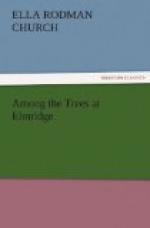“How high does it grow, Miss Harson?” asked Clara.
“From one hundred and fifty to two hundred feet,” was replied, “and on the north-west coast of America one called the ‘Douglas’s pine’ is the loftiest tree known; it is said to measure over three hundred feet. ’From the pines are obtained the best masts and much of the most valuable ship-timber, and in the building and finishing of houses they are of almost indispensable utility. The bark of some of them, as the hemlock and larch, is of great value in tanning, and from others are obtained the various kinds of pitch, tar, turpentine, resin and balsams,’ The pines and firs have circles of branches in imperfect whorls around the trunk, and, as one of these whorls is formed each year, it is easy to calculate the age of young trees. In thick woods the lower whorls of branches soon decay for want of light and air, and this leaves a smooth trunk, which rises without a branch, like a beautiful shaft, for a hundred feet or more.
“These trees are found everywhere except in the hot regions around the equator. The white pine is the most common, but in the evergreen woods of our own country it is mixed with pitch-pine and fir trees. In our Southern States there are thin forests, called pine-barrens, through which one can travel for miles on horseback. The white pine is easily distinguished by its leaves being in fives, by its very long cones, composed of loosely-arranged scales, and when young by the smoothness and delicate light-green color of the bark. It is known throughout New England by the name ‘white pine,’ which is given it on account of the whiteness of the wood. In England it is called the Weymouth pine.
“Many very large trees are found in Maine, on the Penobscot River, but most of the largest and most valuable timber trees have been cut down. The lumberers, as they are called, are constantly hewing down the grand old trees for timber, white pine being the principal timber of New England and Canada.”
“And they float it down the rivers on rafts, don’t they?” said Malcolm. “Won’t you tell us about that, Miss Harson?”
“Yes,” was the reply.—“But do not look so expectant, Edie; it is not a story, dear, only a description of pine-cutting in the forests of Maine and Canada. But I should like you to know how these great trees are turned into timber, and you will see that, like many other necessary things, it is neither easy nor pleasant. We do not get much without hard work on the part of somebody: remember that. Now I will read:
“’The business of procuring trees suitable for masts of ships is difficult and fatiguing. The pines which grew in the neighborhood of the rivers and in the most accessible places have all been cut down. Paths have now to be cleared with immense labor to the recesses of the forest, in order to obtain a fresh supply. This arduous employment is called “lumbering,” and those who engage in it are “lumberers.” The word “lumber,” in its general sense, applies to all kinds of timber. But though many different trees, such as oak, ash and maple, are cut down, yet the main business is with the pines. And when a suitable plot of ground has been chosen for erecting a saw-mill,’ to prepare the boards, ’it is called “pine-land,” or a spot where the pine trees predominate.




